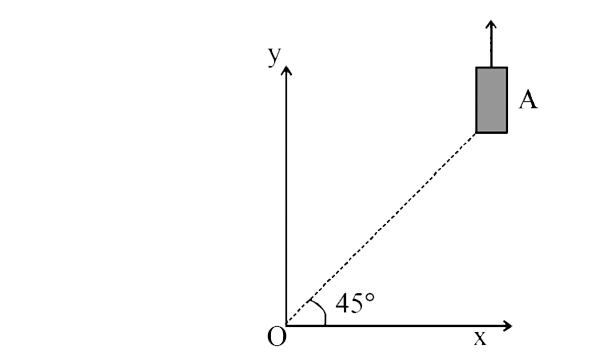The sides of a touch the conjugate hyperbola of the hyperbola . If the vertex lies on the ellipse , then the side must touch parabola (b) circle hyperbola (d) ellipse
To solve the problem, we need to analyze the relationship between the triangle ABC, the hyperbola, and the ellipse given in the question.
1. Identify the Given Hyperbola and Ellipse:
- The hyperbola is given by the equation:
x2a2−y2b2=1
- The conjugate hyperbola is:
y2b2−x2a2=1
- The ellipse is given by:
x2a2+y2b2=1
2. Vertex of Triangle A:
- Let the vertex A be at the coordinates (acosθ,bsinθ) since it lies on the ellipse.
3. Tangents to the Conjugate Hyperbola:
- Since the sides AC and AB touch the conjugate hyperbola, we can write the equation of the tangent to the conjugate hyperbola at point A:
x⋅acosθa2−y⋅bsinθb2=1
- Rearranging gives:
xcosθ−ybsinθa=1
4. Equation of the Side BC:
- The side BC can be considered as a chord of contact from point A to the ellipse. The equation of the chord of contact from point (x1,y1) to the ellipse is:
xx1a2+yy1b2=1
- Substituting x1=acosθ and y1=bsinθ:
xx1a2+yy1b2=x(acosθ)a2+y(bsinθ)b2=1
5. Conclusion:
- The equation derived represents a tangent to the ellipse. Therefore, the side BC must touch the ellipse.
Final Answer:
The side BC must touch the ellipse.
- The hyperbola is given by the equation:
x2a2−y2b2=1
- The conjugate hyperbola is:
y2b2−x2a2=1
- The ellipse is given by:
x2a2+y2b2=1
- Let the vertex A be at the coordinates (acosθ,bsinθ) since it lies on the ellipse.
- Since the sides AC and AB touch the conjugate hyperbola, we can write the equation of the tangent to the conjugate hyperbola at point A:
x⋅acosθa2−y⋅bsinθb2=1
- Rearranging gives:
xcosθ−ybsinθa=1
- The side BC can be considered as a chord of contact from point A to the ellipse. The equation of the chord of contact from point (x1,y1) to the ellipse is:
xx1a2+yy1b2=1
- Substituting x1=acosθ and y1=bsinθ:
xx1a2+yy1b2=x(acosθ)a2+y(bsinθ)b2=1
- The equation derived represents a tangent to the ellipse. Therefore, the side BC must touch the ellipse.
The side BC must touch the ellipse.
Topper's Solved these Questions
- COMPLEX NUMBERS AND QUADRATIC EQUATIONSBook:CENGAGE ENGLISHChapter:COMPLEX NUMBERS AND QUADRATIC EQUATIONSExercise:All Questions
Explore 886 Videos
- DIFFERENT PRODUCTS OF VECTORS AND THEIR GEOMETRICAL APPLICATIONS Book:CENGAGE ENGLISHChapter:DIFFERENT PRODUCTS OF VECTORS AND THEIR GEOMETRICAL APPLICATIONS Exercise:Multiple correct answers type
Explore 11 Videos
Similar Questions
No part of the hyperbola x2a2−y2b2=1. Lies between which of the following
View SolutionIf hyperbola x2b2−y2a2=1 passes through the focus of ellipse x2a2+y2b2=1 , then find the eccentricity of hyperbola.
View SolutionIf the line lx+my +n=0 touches the ellipse x2a2+y2b2=1 then
View SolutionIf the line lx+my+n=0 touches the hyperbola x2a2−y2b2=1. Then
View SolutionFind the maximum area of the ellipse x2a2+y2b2=1 which touches the line y=3x+2.
View SolutionShow that the tangents at the ends of conjugate diameters of the ellipse x2a2+y2b2=1 intersect on the ellipse x2a2+y2b2=2.
View SolutionIf the eccentricity of the hyperbola x216−y2b2=−1 is 54, then b2 is equal to
View SolutionThe pole of the line lx+my+n=0 with respect to the hyperbola x2a2−y2b2=1, is
View SolutionThe locus of the poles of the tangents to the ellipse x2a2+y2b2=1 w.r.t. the circle x2+y2=a2 is: (a) parabola (b) ellipse (c) hyperbola (d) circle
View SolutionOn a frictionless horizontal surface , assumed to be the x−y plane , a small trolley A is moving along a straight line parallel to the y−axis ( see figure) with a constant velocity of (√3−1)m/s . At a particular instant , when the line OA makes an angle of 45(∘) with the x− axis , a ball is thrown along the surface from the origin O. Its velocity makes an angle ϕ with the x− axis and it hits the trolley .
(a) The motion of the ball is observed from the frame of the trolley . Calculate the angle θ made by the velocity vector of the ball with the x−axis in this frame .
(b) Find the speed of the ball with respect to the surface , if ϕ=(4θ)/(3).

View Solution